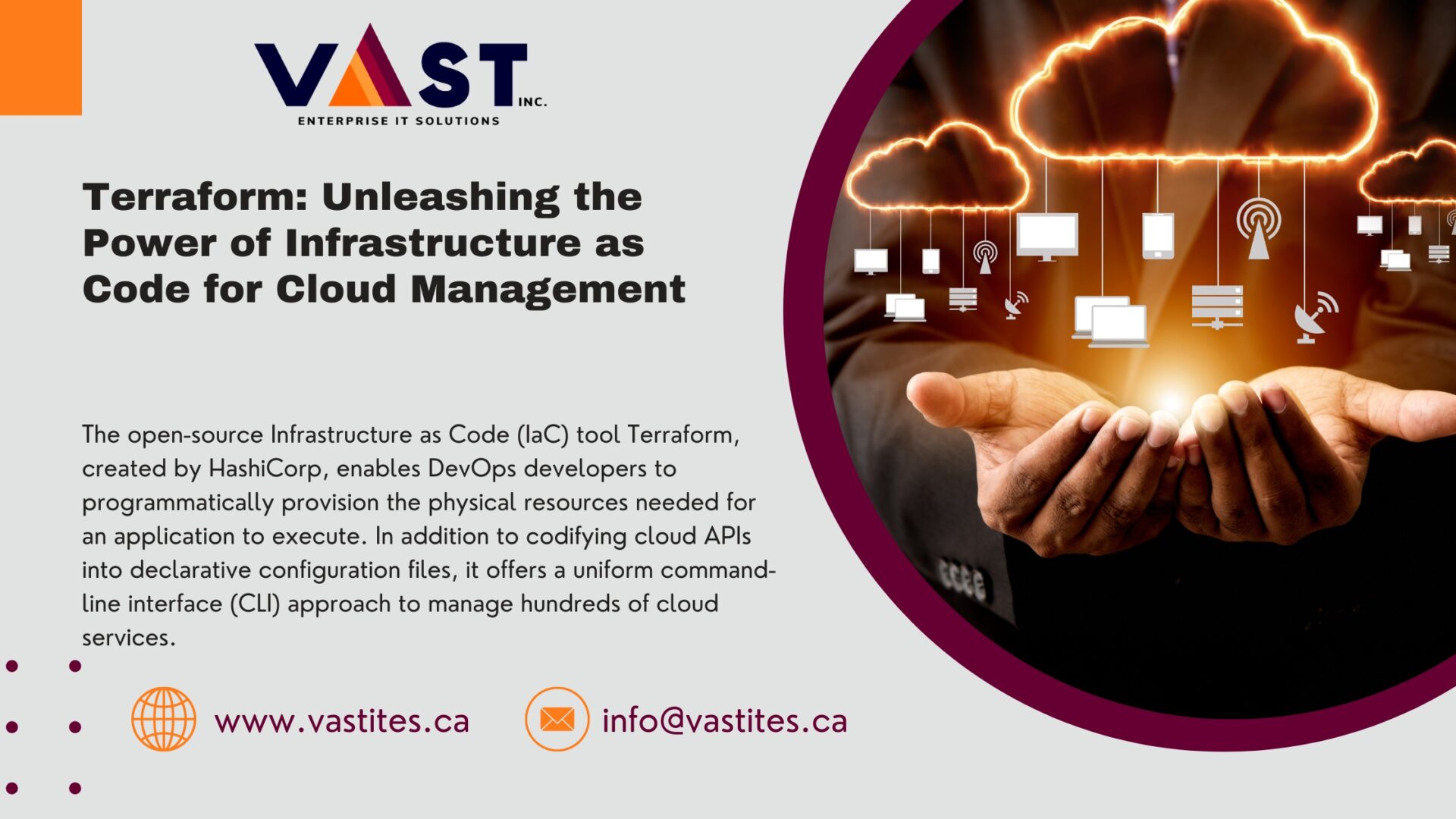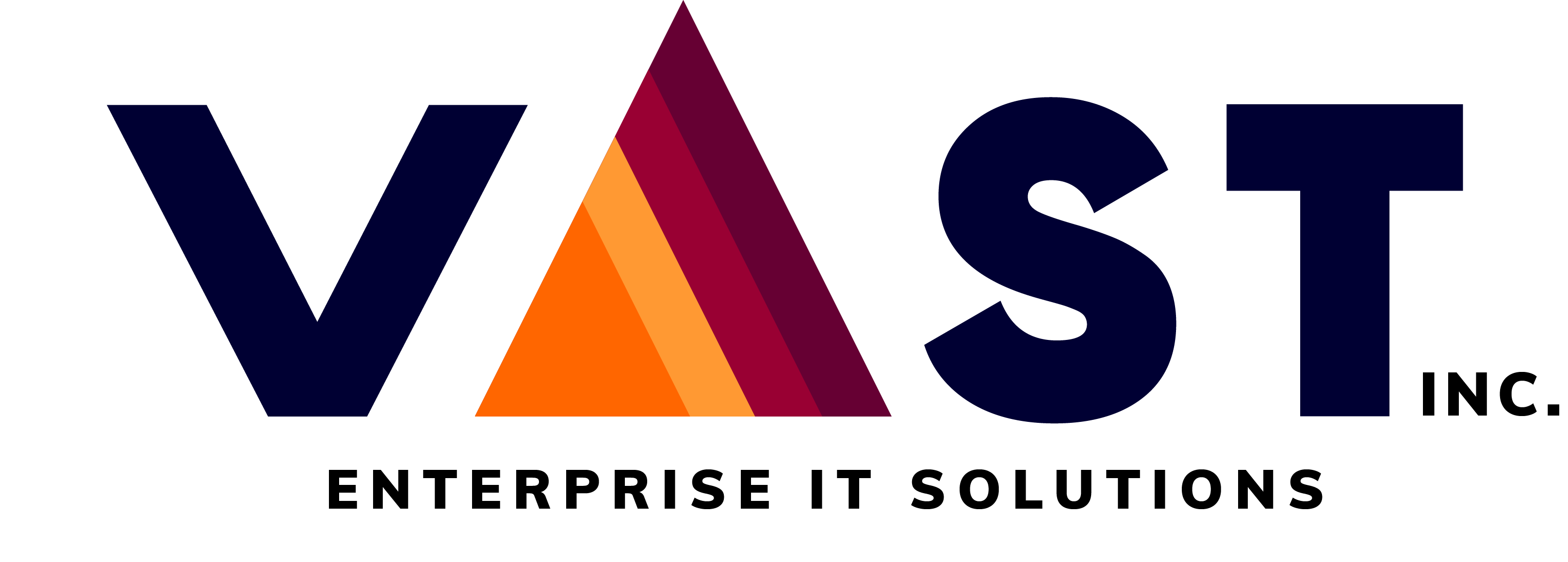
- August 2, 2023
- vastadmin
- 0
What is terraform?
The open-source Infrastructure as Code (IaC) tool Terraform, created by HashiCorp, enables DevOps developers to programmatically provision the physical resources needed for an application to execute. In addition to codifying cloud APIs into declarative configuration files, it offers a uniform command-line interface (CLI) approach to manage hundreds of cloud services. Terraform’s main features include its high-level configuration language (HCL), which IT professionals use to describe infrastructure in human-readable, declarative configuration files, and execution plans, which are created once the user describes the infrastructure.
What programming language is used in Terraform?
Enter HCL – The Language of Terraform:
At the heart of Terraform lies the HashiCorp Configuration Language (HCL). HCL is specifically designed to be both human-readable and machine-friendly, making it easier for teams to collaborate and manage infrastructure code effectively.
HCL’s Syntax:
The syntax of HCL is straightforward and resembles JSON. It consists of key-value pairs, where the keys represent the configuration settings, and the values define the desired state.
Readability:
HCL’s syntax is intuitive and easy to understand, even for those without a strong programming background. This enables team members with different skill sets to collaborate on infrastructure code effectively.
Reusability:
HCL code can be organized into modules, allowing you to create reusable components that represent common infrastructure patterns. These modules can be shared and leveraged across multiple projects, promoting consistency and reducing duplication.
Consistency:
By defining infrastructure in code, Terraform ensures that the environment remains consistent throughout its lifecycle. This eliminates manual configuration discrepancies and reduces the risk of human error.
How is Terraform from Hashicorp different
One of the key differentiators of Terraform from other IaC tools is that it is not agent-based, meaning it does not need to install any software on the managed infrastructure. This feature liberates its users from the hassle that most automation and IaC tools present. In addition, HashiCorp Configuration Language (HCL), a fully functional and immutable-based programming language, is used to create Terraform. It contains loops, of statements, variables, and much of the logic present in other programming languages.
Is Terraform from Hashicorp used by tech companies?
Terraform, a robust Infrastructure as Code (IaC) tool, has gained immense popularity due to its versatility and ease of use. HashiCorp’s Terraform has emerged as a preferred tool among tech companies worldwide.
Numerous prominent tech companies have publicly shared their success stories with Terraform. For example:
Pinterest:
Pinterest, a popular image-sharing platform, utilizes Terraform to manage its AWS infrastructure. They highlight Terraform’s scalability and ease of adoption as key factors in their choice.
GitLab:
GitLab, a leading DevOps platform, uses Terraform to manage its multi-cloud infrastructure. They appreciate Terraform’s declarative syntax and its support for multiple cloud providers, enabling them to provide a consistent user experience across different environments.
DigitalOcean:
DigitalOcean, a cloud infrastructure provider, offers a Terraform provider to allow users to manage their DigitalOcean resources through code. This exemplifies Terraform’s adoption within the cloud service provider industry as well.
What is the use of Terraform in Alibaba Cloud?
While the instruction asks about the use of Terraform in Alibaba Cloud, the provided context does not contain this specific information. Similarly, a direct comparison between Terraform and CloudFormation in terms of user-friendliness is not provided in the context.
Alibaba Cloud, one of the leading cloud service providers, offers a vast array of services and resources to cater to modern businesses’ needs. To harness the full potential of Alibaba Cloud’s offerings efficiently, Infrastructure as Code (IaC) becomes invaluable. Enter Terraform, a powerful open-source tool that streamlines the management of Alibaba Cloud infrastructure through code.
Terraform provides native support for Alibaba Cloud, making it seamless for users to define and manage resources on the platform. Alibaba Cloud’s Resource Orchestration Service (ROS) acts as the backend for Terraform, enabling robust communication and resource provisioning. This integration ensures that any changes made to the infrastructure through Terraform are automatically reflected in the Alibaba Cloud environment.
Key Use Cases of Terraform in Alibaba Cloud:
Provisioning Resources:
With Terraform, you can effortlessly create a wide range of Alibaba Cloud resources, such as Elastic Compute Service (ECS) instances, Virtual Private Clouds (VPCs), Object Storage Service (OSS) buckets, and more. By codifying the infrastructure, you eliminate the manual setup process, reducing human errors and saving valuable time.
Scalability and Flexibility:
Alibaba Cloud’s scalability is a significant advantage for businesses experiencing rapid growth. Terraform allows you to define scalable architectures and automate resource scaling based on demand. This flexibility ensures your applications can handle varying workloads efficiently.
Cost Management:
Terraform’s ability to manage infrastructure as code also extends to cost optimization. You can utilize variables and logic within your Terraform code to control resource allocation, select the appropriate instance types, and apply cost-effective pricing plans, ultimately optimizing your cloud spending.
Security and Compliance:
Ensuring compliance and adhering to security best practices is a top priority for any business. Terraform’s version-controlled and auditable codebase enhances the visibility and traceability of infrastructure changes, promoting a more secure and compliant environment on Alibaba Cloud.
Automated Workflows:
Leveraging Terraform’s capabilities, you can create automated workflows to deploy and manage complex Alibaba Cloud infrastructures. This means you can establish a complete infrastructure setup with a single command, promoting consistency and reproducibility across environments.
Which one is more user-friendly: Terraform or CloudFormation?
Terraform, developed by HashiCorp, boasts a reputation for its user-friendly nature and human-readable language. It relies on the HashiCorp Configuration Language (HCL) or optionally JSON, YAML, or other configuration formats to define infrastructure. Here are some key factors contributing to Terraform’s user-friendliness:
Simple and Intuitive Syntax:
HCL’s syntax is designed to be easy to read and understand, making it accessible to both developers and operations teams. The declarative approach of Terraform allows users to specify the desired state of resources without worrying about the underlying implementation details.
Multi-Cloud and Multi-Platform Support:
Terraform’s versatility extends beyond AWS and covers various cloud providers, including Azure, Google Cloud Platform, and more. It also supports on-premises infrastructure and third-party services, providing users with a consistent interface across different environments.
Resource Reusability:
Terraform allows you to create reusable modules, enabling teams to share and collaborate on infrastructure components. This modularity promotes consistency and efficiency in managing cloud resources.
Graphical Representation:
Terraform’s “plan” and “graph” commands generate visual representations of the infrastructure changes, offering a clear overview of the planned modifications. This helps users verify their configurations before applying them.
AWS CloudFormation – Simplifying AWS Infrastructure:
As an Amazon Web Services (AWS) service, AWS CloudFormation focuses on streamlining the provisioning and management of AWS resources. While it is tightly integrated with the AWS ecosystem, its user-friendliness also comes from various factors:
Familiarity with AWS Resources:
CloudFormation leverages YAML or JSON templates, and since they are AWS-specific, users familiar with AWS resources can easily adapt to defining their infrastructure using these templates.
AWS-Specific Abstractions:
CloudFormation offers AWS-specific constructs like “AWS::EC2::Instance” or “AWS::S3::Bucket,” which closely resemble the AWS services they represent. This makes it straightforward for AWS-centric teams to understand and use these templates.
AWS Management Console Integration:
AWS CloudFormation can be managed through the AWS Management Console, providing users with a graphical interface to design, visualize, and manage their cloud resources.
Stack Management:
CloudFormation introduces the concept of “stacks,” enabling users to create, update, and delete collections of resources together, making it easier to manage complex infrastructures.
Both Terraform and AWS CloudFormation offer user-friendly approaches to Infrastructure as Code, catering to different user preferences and requirements. Terraform’s cross-cloud support, simple syntax, and resource reusability make it appealing for teams working in diverse cloud environments. On the other hand, AWS CloudFormation’s tight integration with AWS services and the ease of management through the AWS Management Console makes it an excellent choice for AWS-centric teams.
Ultimately, the choice between Terraform and AWS CloudFormation depends on factors such as your team’s expertise, your cloud provider preferences, and the level of flexibility and abstraction you desire. Embrace the power of Infrastructure as Code with either of these tools, and simplify your cloud infrastructure management for a more agile and scalable future.
What is Terraform best used for? Why should one choose it over other options when working with Amazon Web Services (AWS), such as CloudFormation?
However, when working with Amazon Web Services (AWS), one might choose Terraform over other options like CloudFormation due to its ability to manage both low-level components like compute, storage, and networking resources, as well as high-level components like DNS entries and SaaS features. Terraform also offers flexibility in managing resources across multiple platforms and providers, making it a versatile tool for managing a wide range of infrastructure needs.
Terraform’s Best Use Cases:
Multi-Cloud Orchestration:
Terraform shines when it comes to managing infrastructure across multiple cloud providers. Organizations with a multi-cloud strategy can leverage Terraform to define resources consistently across AWS, Azure, Google Cloud, and more. This portability reduces vendor lock-in and ensures seamless management in a heterogeneous cloud environment.
Cross-Platform Support:
Apart from cloud providers, Terraform supports various platforms like on-premises data centers, networking equipment, and SaaS offerings. This allows teams to manage their entire infrastructure, including hybrid scenarios, using a unified toolset.
Infrastructure Composition with Modules:
Terraform’s module-based approach allows you to create reusable components representing common infrastructure patterns. These modules can be shared within the organization or the Terraform community, accelerating development and ensuring consistent, battle-tested configurations.
State Management and Versioning:
Terraform maintains a state file that tracks the current infrastructure configuration. This file serves as a source of truth and helps Terraform identify changes needed to reach the desired state. Furthermore, Terraform’s version control integration allows for team collaboration and history tracking.
Why Choose Terraform over AWS CloudFormation?
Cross-Cloud Flexibility:
While AWS CloudFormation excels in managing AWS resources, Terraform offers cross-cloud capabilities. If your organization has a multi-cloud strategy or is considering a shift to other cloud providers, Terraform provides a consistent and portable approach to manage your infrastructure.
Easier Learning Curve:
Terraform’s declarative syntax, especially using HashiCorp Configuration Language (HCL), is considered more approachable and readable than the JSON or YAML templates used in AWS CloudFormation. This simplicity allows for quicker adoption and easier onboarding of new team members.
Broader Community and Ecosystem:
Terraform boasts a vast and active community with extensive third-party provider support. This means you can leverage community-driven modules and integrations, accelerating your infrastructure deployment and management.
Modularity and Composition:
While both tools support templates, Terraform’s modular design promotes reusability and composition of infrastructure components. AWS CloudFormation also provides nested stacks, but Terraform’s modules are considered more flexible and easier to manage.
Conclusion:
In conclusion, Terraform, developed by HashiCorp, is a powerful Infrastructure as Code (IaC) tool that offers a user-friendly, versatile, and cross-platform solution for cloud infrastructure management. With its high-level configuration language, modularity, and automation capabilities, Terraform empowers tech companies to provision resources efficiently, ensure consistency, and scale with ease. By adopting Terraform, organizations can embrace the agility and standardization of Infrastructure as Code, propelling their cloud-native journeys to new heights. Partner with VaST ITES Inc, the best cloud consulting in Toronto, and harness the full potential of Terraform to optimize your cloud infrastructure and accelerate business growth.
